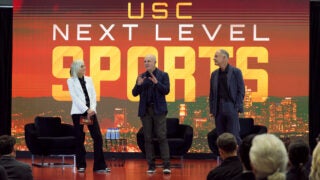As L.A. soaks, USC Village puts stormwater collection system to use
Hardly a drop is wasted as elaborate system gathers runoff, removing debris and contaminants in the process
As USC Village got its first soaking from the sky since opening in August, students and shoppers scurried to avoid the rain.
Far below the surface, a complex system was in place to save almost every drop. In terms of depth, we’re talking about 150 feet — the height of the clock tower atop McCarthy Honors College.
USC Village’s stormwater collection system functions completely out of sight, gathering up to 98,000 gallons of runoff through 57 area drains on the 15-acre site. The runoff is sent to drywells 6 feet in diameter and up to 60 feet deep.
A rock filtration system, which undergoes a thorough cleanout twice a year, removes contaminants and debris. The filtered runoff seeps through at least another 10 feet or more of alluvium before it gets anywhere near the large aquifer below.
Working for scale
“This system is unlike anything we’ve built before, and nobody is doing this on the scale we are,” said Lloyd Silberstein, USC vice president of capital construction development. “We go above and beyond with all our systems’ engineering.”
Installed when the groundwork was laid for the massive development, the system was capturing stormwater long before it opened.
“During the design phase, NOAA [the National Oceanic and Atmospheric Administration] was predicting one of the largest El Niños to hit Southern California in history,” said Willy Marsh, USC capital construction development director. “We were looking at drywells and realizing that they might become really valuable to us sooner than we realized.”
While the El Niño of 2015-16 fell short of expectations, the drywell system helped construction stay on schedule at USC, keeping the site dry enough for work to proceed during heavy rains.
A perfect place to save rainwater
The University Park Campus is uniquely suited to catch and clean stormwater, according to Travis Longcore, assistant professor of architecture, spatial sciences and biological sciences at the USC School of Architecture. Longcore specializes in urban ecology and conservation research.
We sit on some of the best subsoils in the L.A. basin to do this.
Travis Longcore
“We sit on some of the best subsoils in the L.A. basin to do this,” Longcore said. “It’s sandy, gravely sediment that’s really excellent for infiltrating water quite deep.”
An age-old idea, stormwater capture found new life beginning with the 1972 Clean Water Act requiring stormwater to be cleaned, as well as a statewide push over the last decade to fight drought on multiple fronts.
“If we look back at Los Angeles a hundred years ago, the runoff was nothing like what we have today because of the paving needed for transportation, industry and housing,” Longcore said. “Saving stormwater is one step toward retrofitting an urbanized watershed, and it’s a good example of how we should be retrofitting to capture and clean water. Every step like this takes us closer to restoration of our groundwater supply.”



